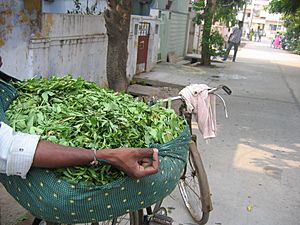Gongura facts for kids
Gongura (also called Puntikura) is a leafy green plant grown for its edible leaves. It's a type of roselle plant (its scientific name is Hibiscus sabdariffa). People in India and other countries like Fiji use these leaves in their cooking. They give a unique sour taste to many dishes.
Gongura plants come in two main types: one with green stems and another with red stems. The red-stemmed variety is usually more sour than the green one. Gongura leaves are very healthy! They are full of good things like iron, vitamins, folic acid, and antioxidants, which are all important for your body.
Contents
Where Gongura is Popular
Gongura is especially popular in the southern Indian state of Andhra Pradesh. People there love it so much that they sometimes call it Andhra Matha, which means "Mother Andhra" in the Telugu language. This shows how important it is in their daily meals.
Different Names for Gongura
This plant is known by many names across India:
- In Tamil Nadu, it's called pulichakeerai.
- In Odisha, it's known as gorkura or khata palangaw.
- In Kerala, you might hear it called Mathippuli or Pulivenda.
- In Karnataka, it's known as Pundi Palle or Punde soppu.
- In Maharashtra, it's called Ambaadi.
- In Hindi, it's Pitwaa.
- In Bengali, it's Mestapat.
- In the Bodo community of Assam, it's called Mwitha.
Gongura is a summer crop. The hotter the place where it grows, the more sour its leaves become!
How Gongura is Used in Cooking

One of the most famous dishes made with Gongura is Gongura pachadi. This is a type of chutney or relish that is a must-have in Andhra cuisine. While it's eaten a lot in homes, it's also very popular in restaurants and food stalls.
As the Gongura leaf grows, it changes shape. A young leaf is a single, full leaf. But as it gets older, it splits into four or more parts.
Popular Gongura Dishes
Besides pachadi, many other tasty dishes are made with Gongura:
- Gongura pappu: This is a delicious lentil dish made with Gongura leaves.
- Gongura mamsam: A curry made with goat or mutton and Gongura.
- Gongura royyalu: A dish that combines shrimp with the sour taste of Gongura.
- Gongura Chicken: A newer favorite, often found in restaurants.
In the Bodo community of Assam, Mwitha (Gongura) is often cooked with non-vegetarian items like pork (Mwitha-Oma), fish (Mwitha-na), or prawns (Mwitha-nathur). The sour taste and slightly slippery texture of the leaves mix well with these ingredients. People in the Bodo community believe that eating sour foods helps them stay healthy during the hot summer.
Other Gongura Recipes
Here are a few more popular curries and pickles made with Gongura:
- Pulla Gongura (Gongura with red chilies)
- Pulihara Gongura (Gongura and tamarind)
- Gongura Pulusu (Gongura stew)
Images for kids






